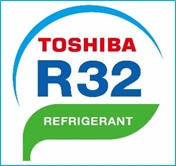
How It Works
| INDOOR UNIT TYPE: there are four types of refrigerant containing indoor appliances for flammability | ||
| Height factor for indoor unit |
Floor Mounted | 0.6 |
| Window | 1.0 | |
| Wall Mounted | 1.8 | |
| Ceiling Mounted | 2.2 | |
| LOCATION CLASSIFICATION: there are four equipment location classifications | ||
| Location | Examples | |
| Class I | all refrigerant equipment is located within the occupied space | Fridge, freezer, window unit, portable unit |
| Class II | Indoor unit(s) and pipework is in conditioned space and all compressors and pressure vessels are in a machinery room or in open air |
Split system, evaporator with remote condenser |
| Class III | all refrigerating equipment is located in a machinery room or in open air | Chiller, rooftop unit |
| Class IV | all refrigeration equipment is in a ventilated enclosure | Unitary package appliance |
| ACCESS CLASSIFICATION: there are three access types | ||
| Definition | Examples | |
| A | People may sleep; The number of people present is not controlled; Any person has access without being personally acquainted with the personal safety precautions |
Hospitals and nursing homes prisons, theatres, lecture halls, supermarkets, restaurants, hotels, transport terminals ice rinks |
| B | Only a limited number of people may be assembled, some of them being necessarily acquainted with the general safety precautions; May be a room or part of a building |
Laboratories Places for general manufacturing Office buildings |
| C | Not open to the general public where only authorised persons are granted access; Authorised persons are acquainted with general safety precautions |
Refineries Non-public areas in supermarkets Manufacturing facilities (e.g. chemicals, food) Cold stores and abattoirs |
| CATEGORY CLASSIFICATION: there are three category types | ||
| Definition | ||
| Human comfort | Air treatment for occupants | |
| Other application | Data rooms, archives, storage, cold room | |
| <1 Person per 10 m² | Authorised access risk aware | |
| OTHER CRITERIA: additional design considerations | ||
| Selection | Choice | Effect |
| Compressor | Open air or machinery room | Requirement for emergency ventilation |
| Underground | Yes | Reduced charge limit restriction |
| Calculation method | C.2 or C.3 | C.2 flammability; C.3 refrigerant concentration |
| Emergency ventilation | Yes | Emergency ventilation rate m3/h |
| Multiple indoor unit check | Indoor versus outdoor capacity | 25% capacity restriction |
| Effect on flow down | Refrigerant charge versus floor volume | Concentration limit restriction |
| Air change rate | Air change rate versus room volume | Ventilation rate m3/h |
Warnings on Refrigerant Leakage
R32 refrigerant is used in the air conditioner has a classification A2L lower toxicity lower flammability rating. If R32 refrigerant leaks and comes into contact with fire or heating part, it will create harmful gas and there is risk of fire. R32 refrigerant poses a potential risk of suffocation if its concentration should rise excessively. If an air conditioner system is installed in a small room, select a suitable model and installation procedure so that if the refrigerant accidentally leaks out, its concentration does not reach or exceed the limit. In a room where the concentration may exceed the limit, create an opening(s) with adjacent room(s) (that cannot be closed), or install mechanical ventilation combined with a gas leak detection device.Privacy Policy


R32 RCL: Refrigerant Concentration Limit in kg/m3
| Cap Factor |
Volume m3 |
LFL (kg/m3) |
Not more than (kg) |
Factor | Max. Limit up to (kg) |
|
|---|---|---|---|---|---|---|
| m1 | 4 | 0.307 | 1.23 | 1.5 | 1.84 | No restriction |
| m2 | 26 | 0.307 | 7.98 | 1.5 | 11.97* | 1 Measure required + leak detection |
| m3 | 130 | 0.307 | 39.91 | 1.5 | 59.87** | 2 Measures required + leak detection |
| * Max. charge occupied space | ** Max. charge unoccupied space | |||||
Information referenced from EN378:2016 and issued for guidance only
Location classification of refrigerant system
I; II; III; IVAccess
General; Supervised; AuthorisedCategory
Human comfort; Other application; Person densityR32 QLMV: Quantity Limit with Minimum Ventilation in kg/m3
| Lower Flammability Limit (LFL) (kg/m3) |
Indoor Unit Type |
Height (m) |
Length (m) |
Width (m) |
Height (m) |
Reduce Volume by (m3) |
Flammability Maximum Charge Limit (kg) |
|---|---|---|---|---|---|---|---|
| 0.307 | |||||||
| Location: | ||
| Access: | ||
| Category: | ||
| Compressor: | ||
| Underground: |
|
|
||||||||||||||||||||||||||||||||
R32 QLMV Check: effect of flow down
| Building Lowest Floor Dimensions | ||||
(kg) |
Length (m) |
Width (m) |
Height (m) |
|
| R32 Largest system charge | ||||
| Installed Refrigerant Concentration | ||||
Air change rate: effect of room size
| Air change rate required | Length (m) |
Width (m) |
Height (m) |
|
| Air volume required m3/h |
Please note
Information extracted from EN378:2016 and issued for guidance only.
Toshiba does not accept any responsibility for information displayed in this calculation tool.
